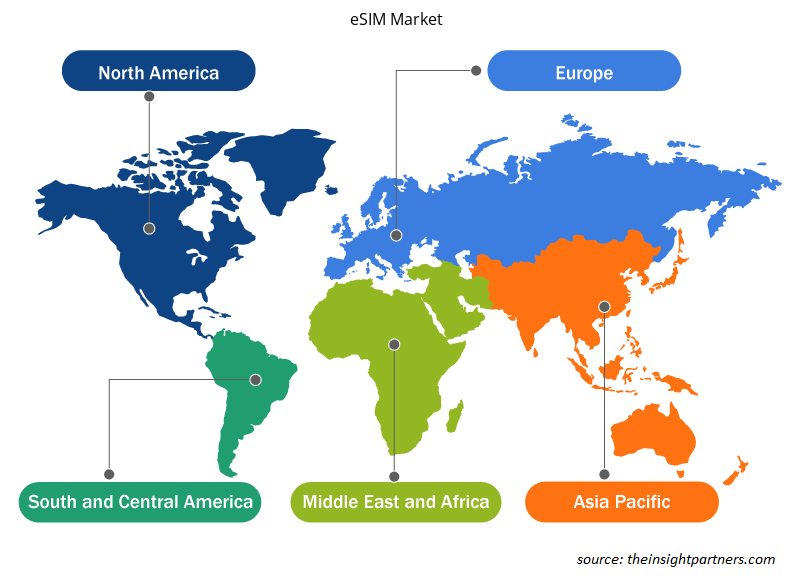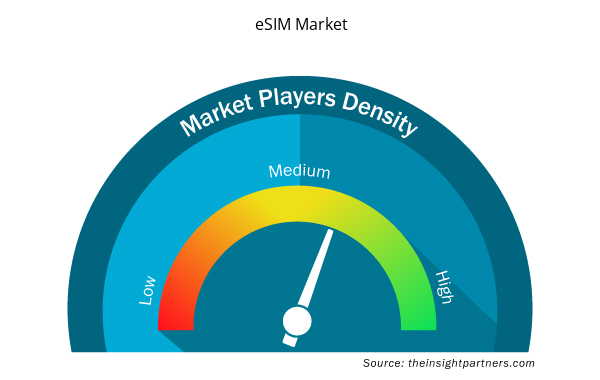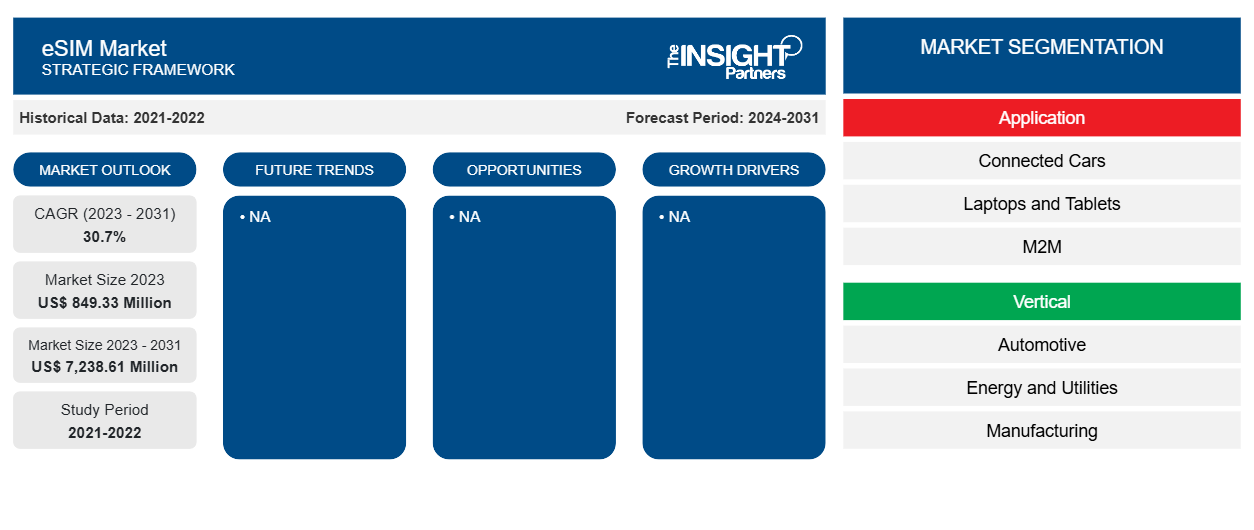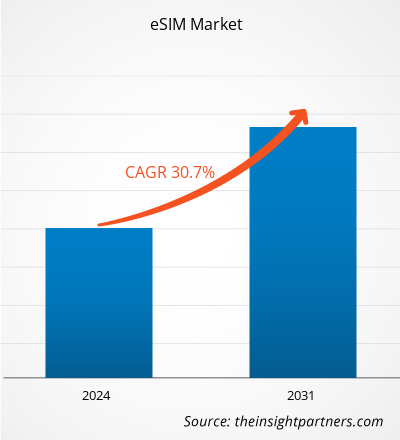من المتوقع أن يصل حجم سوق eSIM إلى 7,238.61 مليون دولار أمريكي بحلول عام 2031 من 849.33 مليون دولار أمريكي في عام 2023. ومن المتوقع أن يسجل السوق معدل نمو سنوي مركب بنسبة 30.7٪ في الفترة 2023-2031. ومن المرجح أن يظل التبني المتزايد لتقنية إنترنت الأشياء بين العملاء اتجاهًا رئيسيًا في سوق eSIM.
تحليل سوق eSIM
يشهد سوق eSIM نموًا سريعًا بسبب التركيز المتزايد على توفير بطاقات SIM عن بُعد للاتصالات بين الأجهزة والطلب المتزايد على الأجهزة الإلكترونية الاستهلاكية المبتكرة بين المستهلكين. ويتوسع السوق بشكل مطرد، مدفوعًا باللوائح الحكومية المواتية لاتصالات الأجهزة بين الأجهزة. وعلاوة على ذلك، يوفر الطلب المتزايد على الحلول الذكية فرصًا مربحة لنمو السوق.
نظرة عامة على سوق eSIM
eSIM، أو وحدة هوية المشترك المدمجة، هي بطاقة SIM رقمية يتم دمجها بسهولة في جهاز محمول مثل الكمبيوتر اللوحي أو الهاتف الذكي. وعلى النقيض من بطاقات SIM المادية التقليدية، والتي يمكن إزالتها واستبدالها، يتم دمج eSIM بسلاسة في البنية الأساسية للأجهزة ويمكن برمجتها بعناية مع مجموعة واسعة من ملفات تعريف الشبكة المحمولة. تتيح هذه الوظيفة للمستهلكين التبديل بسلاسة بين شركات الاتصالات وتشغيل خطط الهاتف المحمول أو تعديلها بسهولة دون الحاجة إلى استبدال بطاقة SIM المادية.
لقد سمح تقديم eSIM في صناعة السيارات بمرونة أكبر في تجهيز الشاحنات والسيارات بالاتصال الخلوي من خلال تنفيذ وظائف إضافية. يخطط قطاع السيارات لتبني الجيل القادم من السيارات المتصلة من خلال دعم مواصفات GSMA Embedded SIM لتحسين اتصال المركبات. ويهدف هذا إلى تحسين الأمان لمجموعة متنوعة من الخدمات المرتبطة. ومع ذلك، تتمتع eSIM بإمكانات هائلة في صناعة السيارات ومن المتوقع أن تخلق فرص نمو خلال فترة التنبؤ.
قم بتخصيص هذا التقرير ليناسب متطلباتك
ستحصل على تخصيص لأي تقرير - مجانًا - بما في ذلك أجزاء من هذا التقرير، أو تحليل على مستوى الدولة، وحزمة بيانات Excel، بالإضافة إلى الاستفادة من العروض والخصومات الرائعة للشركات الناشئة والجامعات
- احصل على أهم اتجاهات السوق الرئيسية لهذا التقرير.ستتضمن هذه العينة المجانية تحليلاً للبيانات، بدءًا من اتجاهات السوق وحتى التقديرات والتوقعات.
محركات وفرص سوق eSIM
التركيز المتزايد على توفير بطاقات SIM عن بعد لشبكات M2M لصالح السوق
يتيح التزويد عن بُعد للمستخدمين تنزيل ملف تعريف المشغل على بطاقة SIM في السوق وتغيير أو حذف ملفات تعريف وحدة هوية المشترك (SIM) دون الوصول فعليًا إلى بطاقة SIM. تعد بطاقة eSIM مكونًا أساسيًا لاتصالات الجهاز إلى الجهاز (M2M)، والتي تتضمن اتصالات محمولة بسيطة وسلسة لجميع أشكال الأجهزة المرتبطة. تتطلب M2M اتصالاً شاملاً عبر المناطق الجغرافية. تعمل eSIM على التخلص من إزعاج تغيير مقدمي الخدمة، وزيادة الكفاءة التشغيلية، والوظائف في بيئة خاضعة للرقابة وآمنة. تضمن أحدث بطاقات eSIM توافق الملف الشخصي وتوفر منصة رئيسية للاعبين للتعاون على أسس مشتركة.
الطلب المتزايد على الحلول الذكية – فرصة في eSIM
يتم استخدام العديد من الحلول الذكية، مثل المركبات الكهربائية والمدن الذكية والعدادات الذكية، بشكل متزايد في جميع أنحاء العالم بسبب المرونة والاتصال الذي توفره البنية التحتية لإنترنت الأشياء، مما يؤدي إلى تسريع نمو المدن الذكية والبنية التحتية في الدول الناشئة. يعد تطور وتوسع الشبكات، وانخفاض تكلفة مكونات الأجهزة، بما في ذلك المحركات والمستشعرات، وظهور نماذج أعمال جديدة، من العوامل الرئيسية التي تقدم خدمات مثل نشر الشبكة الذكية وأنظمة الأمان الأوتوماتيكية والسيارات المتصلة وغيرها الكثير. وهذا يؤدي إلى زيادة الاستثمار في تطوير حلول ذكية مبتكرة للعملاء. وبالتالي، فإن الحاجة المتزايدة إلى الحلول الذكية بين العديد من الصناعات مثل السيارات والطاقة والمرافق والتصنيع وتجارة التجزئة والإلكترونيات الاستهلاكية والنقل والخدمات اللوجستية وغيرها تخلق فرصًا للمشاركين في سوق eSIM خلال فترة التنبؤ.
تحليل تجزئة تقرير سوق شرائح eSIM
إن القطاعات الرئيسية التي ساهمت في استخلاص تحليل سوق eSIM هي قطاع التطبيق والقطاع الرأسي.
- بناءً على التطبيق، ينقسم سوق eSIM إلى السيارات المتصلة، وأجهزة الكمبيوتر المحمولة والأجهزة اللوحية، وأجهزة M2M، والهواتف الذكية، والأجهزة القابلة للارتداء، وغيرها. احتل قطاع أجهزة M2M حصة سوقية أكبر في عام 2023.
- على أساس عمودي، يتم تقسيم السوق إلى قطاعات السيارات والطاقة والمرافق والتصنيع والتجزئة والإلكترونيات الاستهلاكية والنقل والخدمات اللوجستية وغيرها. احتل قطاع الإلكترونيات الاستهلاكية الحصة الأكبر من السوق في عام 2023.
تحليل حصة سوق eSIM حسب المنطقة الجغرافية
ينقسم النطاق الجغرافي لتقرير سوق eSIM بشكل أساسي إلى خمس مناطق: أمريكا الشمالية، وآسيا والمحيط الهادئ، وأوروبا، والشرق الأوسط وأفريقيا، وأمريكا الجنوبية/أمريكا الجنوبية والوسطى. من حيث الإيرادات، استحوذت أمريكا الشمالية على أكبر حصة في سوق eSIM، وذلك بسبب التقدم التكنولوجي.
من المتوقع أن يتوسع سوق آسيا والمحيط الهادئ بمعدل نمو سنوي مركب كبير خلال فترة التنبؤ. يتم تقسيم السوق في هذه المنطقة إلى أستراليا والصين واليابان والهند وكوريا الجنوبية وبقية منطقة آسيا والمحيط الهادئ. وقد أدى وجود لاعبين رئيسيين في مجال الهواتف الذكية مثل Huawei Technologies Co Ltd وSamsung Electronics Co Ltd إلى تطوير هواتف eSIM، مما يسرع من اعتماد eSIM في سوق الهواتف الذكية. علاوة على ذلك، يتم تمثيل eSIM أيضًا كمستقبل لتقنية SIM للأجهزة المتصلة. بالإضافة إلى ذلك، تقوم العديد من شركات تصنيع المعدات الأصلية من دول مثل الصين والهند بإنشاء حلول eSIM وتشكيل فرق تطوير تعاونية في جميع أنحاء النظام البيئي لإنشاء مسارات تطوير تكتيكية. على سبيل المثال، في يونيو 2021، أنشأت IDEMIA، وهي شركة تصنيع eSIM، منشأة إنتاج جديدة في الهند، ومن المتوقع أن تعمل على توسيع قدرة إنتاج eSIM في جميع أنحاء العالم. وفقًا لشركة الحلول الرقمية الألمانية Giesecke+Devrient (G&D)، ستحتوي 25-30% من الهواتف الذكية على وظيفة eSIM بحلول نهاية عام 2024. ومع ذلك، فإن توسع صناعة الهواتف الذكية المرتبط بالرقمنة المتنامية يخلق فرصًا للسوق خلال فترة التنبؤ.
رؤى إقليمية حول سوق eSIM
قام المحللون في Insight Partners بشرح الاتجاهات والعوامل الإقليمية المؤثرة على سوق eSIM طوال فترة التوقعات بشكل شامل. يناقش هذا القسم أيضًا قطاعات سوق eSIM والجغرافيا في جميع أنحاء أمريكا الشمالية وأوروبا وآسيا والمحيط الهادئ والشرق الأوسط وأفريقيا وأمريكا الجنوبية والوسطى.

- احصل على البيانات الإقليمية المحددة لسوق eSIM
نطاق تقرير سوق eSIM
| سمة التقرير | تفاصيل |
|---|---|
| حجم السوق في عام 2023 | 849.33 مليون دولار أمريكي |
| حجم السوق بحلول عام 2031 | 7,238.61 مليون دولار أمريكي |
| معدل النمو السنوي المركب العالمي (2023 - 2031) | 30.7% |
| البيانات التاريخية | 2021-2022 |
| فترة التنبؤ | 2024-2031 |
| القطاعات المغطاة | حسب الطلب
|
| المناطق والدول المغطاة | أمريكا الشمالية
|
| قادة السوق وملفات تعريف الشركات الرئيسية |
|
كثافة اللاعبين في سوق eSIM: فهم تأثيرها على ديناميكيات الأعمال
يشهد سوق eSIM نموًا سريعًا، مدفوعًا بالطلب المتزايد من جانب المستخدم النهائي بسبب عوامل مثل تفضيلات المستهلكين المتطورة والتقدم التكنولوجي والوعي المتزايد بفوائد المنتج. ومع ارتفاع الطلب، تعمل الشركات على توسيع عروضها والابتكار لتلبية احتياجات المستهلكين والاستفادة من الاتجاهات الناشئة، مما يؤدي إلى زيادة نمو السوق.
تشير كثافة اللاعبين في السوق إلى توزيع الشركات أو المؤسسات العاملة في سوق أو صناعة معينة. وهي تشير إلى عدد المنافسين (اللاعبين في السوق) الموجودين في مساحة سوق معينة نسبة إلى حجمها أو قيمتها السوقية الإجمالية.
الشركات الرئيسية العاملة في سوق eSIM هي:
- شركة دويتشه تيليكوم ايه جي
- جيمالتو NV
- شركة جيزيك ديفرينت المحدودة
- ايديميا
- شركة إنفينيون للتكنولوجيا
- شركة NXP لأشباه الموصلات
إخلاء المسؤولية : الشركات المذكورة أعلاه ليست مرتبة بأي ترتيب معين.

- احصل على نظرة عامة على أهم اللاعبين الرئيسيين في سوق eSIM
أخبار سوق eSIM والتطورات الأخيرة
يتم تقييم سوق eSIM من خلال جمع البيانات النوعية والكمية بعد البحث الأولي والثانوي، والتي تتضمن منشورات الشركات المهمة وبيانات الجمعيات وقواعد البيانات. فيما يلي قائمة بالتطورات في سوق eSIM والاستراتيجيات:
- في فبراير 2023، تعاونت شركة Amdocs Ltd مع شركة Drei Austria لإطلاق حل eSIM مبتكر، مما يسمح لعملاء الشركة النمساوية المشغلة بالاستمتاع بفوائد تقنية eSIM الرقمية في تجربة تعتمد على التطبيق فقط. يمكن لعملاء Drei Austria الذين يستخدمون تطبيق up³ الآن إدارة eSIM الخاصة بهم على الأجهزة التي تنتجها Apple وGoogle وSamsung والمزيد. (المصدر: Amdocs Ltd، بيان صحفي، 2023)
- في ديسمبر 2022، أعلنت شركة جروفر عن إطلاق مشغل شبكة الجوال الافتراضية (MVNO) الخاص بها لعملاء تأجير التكنولوجيا، جروفر كونيكت، في الولايات المتحدة. من خلال جروفر كونيكت، يمكن للعملاء في الولايات المتحدة تنشيط أي جهاز تكنولوجي يدعم eSIM بسهولة دون أي احتكاك. تتوفر جروفر eSIM للعملاء عند الخروج في الولايات المتحدة وسيتم طرحها في أسواقها الأوروبية في المستقبل القريب. (المصدر: جروفر، بيان صحفي، 2022)
- في أكتوبر 2022، أطلقت شركة Bharti Airtel Ltd حل اتصال إنترنت الأشياء "Always On" في الهند. يتألف حل "Always On" من Airtel من شريحة M2M eSIM ثنائية الملف الشخصي والتي تسمح لجهاز إنترنت الأشياء بالبقاء متصلاً دائمًا بشبكة الهاتف المحمول من مشغلي شبكات الهاتف المحمول المختلفة (MNOs) في شريحة eSIM. حل Airtel هو شريحة M2M eSim ثنائية الملف الشخصي متوافقة مع AIS-140، وهي الأنسب لمقدمي خدمات تتبع المركبات وشركات تصنيع السيارات وأي حالات استخدام حيث تعمل المعدات في مواقع نائية تتطلب اتصالاً في كل مكان. (المصدر: Bharti Airtel Ltd، بيان صحفي، 2022)
تقرير سوق eSIM: التغطية والنتائج المتوقعة
يوفر تقرير "حجم سوق eSIM والتوقعات (2021-2031)" تحليلاً مفصلاً للسوق يغطي المجالات التالية:
- حجم السوق والتوقعات على المستويات العالمية والإقليمية والوطنية لجميع قطاعات السوق الرئيسية التي يغطيها النطاق
- ديناميكيات السوق مثل المحركات والقيود والفرص الرئيسية
- الاتجاهات المستقبلية الرئيسية
- تحليل مفصل لقوى PEST/Porter الخمس وSWOT
- تحليل السوق العالمي والإقليمي الذي يغطي اتجاهات السوق الرئيسية واللاعبين الرئيسيين واللوائح والتطورات الأخيرة في السوق
- تحليل المشهد الصناعي والمنافسة الذي يغطي تركيز السوق، وتحليل خريطة الحرارة، واللاعبين البارزين، والتطورات الأخيرة
- ملفات تعريف الشركة التفصيلية
- التحليل التاريخي (سنتان)، السنة الأساسية، التوقعات (7 سنوات) مع معدل النمو السنوي المركب
- تحليل PEST و SWOT
- حجم السوق والقيمة / الحجم - عالميًا وإقليميًا وقطريًا
- الصناعة والمنافسة
- مجموعة بيانات Excel



Report Coverage
Revenue forecast, Company Analysis, Industry landscape, Growth factors, and Trends

Segment Covered
This text is related
to segments covered.

Regional Scope
North America, Europe, Asia Pacific, Middle East & Africa, South & Central America

Country Scope
This text is related
to country scope.
الأسئلة الشائعة
The global eSIM market was estimated to be US$ 849.33 million in 2023 and is expected to grow at a CAGR of 30.7% during the forecast period 2023 - 2031.
The growing focus on remote SIM provisioning for M2M and rising demand for innovative consumer electronics devices among consumers are the major factors that propel the global eSIM market.
The rising adoption of IoT technology among customers is anticipated to play a significant role in the global eSIM market in the coming years.
The key players holding majority shares in the global eSIM market are Deutsche Telekom AG, Thales SA, IDEMIA France SAS, Infineon Technologies AG, and NXP Semiconductors NV.
The global eSIM market is expected to reach US$ 7,238.61 million by 2031.
The incremental growth expected to be recorded for the global eSIM market during the forecast period is US$ 6,389.28 million.
Trends and growth analysis reports related to Electronics and Semiconductor : READ MORE..
The Insight Partners performs research in 4 major stages: Data Collection & Secondary Research, Primary Research, Data Analysis and Data Triangulation & Final Review.
- Data Collection and Secondary Research:
As a market research and consulting firm operating from a decade, we have published and advised several client across the globe. First step for any study will start with an assessment of currently available data and insights from existing reports. Further, historical and current market information is collected from Investor Presentations, Annual Reports, SEC Filings, etc., and other information related to company’s performance and market positioning are gathered from Paid Databases (Factiva, Hoovers, and Reuters) and various other publications available in public domain.
Several associations trade associates, technical forums, institutes, societies and organization are accessed to gain technical as well as market related insights through their publications such as research papers, blogs and press releases related to the studies are referred to get cues about the market. Further, white papers, journals, magazines, and other news articles published in last 3 years are scrutinized and analyzed to understand the current market trends.
- Primary Research:
The primarily interview analysis comprise of data obtained from industry participants interview and answers to survey questions gathered by in-house primary team.
For primary research, interviews are conducted with industry experts/CEOs/Marketing Managers/VPs/Subject Matter Experts from both demand and supply side to get a 360-degree view of the market. The primary team conducts several interviews based on the complexity of the markets to understand the various market trends and dynamics which makes research more credible and precise.
A typical research interview fulfils the following functions:
- Provides first-hand information on the market size, market trends, growth trends, competitive landscape, and outlook
- Validates and strengthens in-house secondary research findings
- Develops the analysis team’s expertise and market understanding
Primary research involves email interactions and telephone interviews for each market, category, segment, and sub-segment across geographies. The participants who typically take part in such a process include, but are not limited to:
- Industry participants: VPs, business development managers, market intelligence managers and national sales managers
- Outside experts: Valuation experts, research analysts and key opinion leaders specializing in the electronics and semiconductor industry.
Below is the breakup of our primary respondents by company, designation, and region:

Once we receive the confirmation from primary research sources or primary respondents, we finalize the base year market estimation and forecast the data as per the macroeconomic and microeconomic factors assessed during data collection.
- Data Analysis:
Once data is validated through both secondary as well as primary respondents, we finalize the market estimations by hypothesis formulation and factor analysis at regional and country level.
- Macro-Economic Factor Analysis:
We analyse macroeconomic indicators such the gross domestic product (GDP), increase in the demand for goods and services across industries, technological advancement, regional economic growth, governmental policies, the influence of COVID-19, PEST analysis, and other aspects. This analysis aids in setting benchmarks for various nations/regions and approximating market splits. Additionally, the general trend of the aforementioned components aid in determining the market's development possibilities.
- Country Level Data:
Various factors that are especially aligned to the country are taken into account to determine the market size for a certain area and country, including the presence of vendors, such as headquarters and offices, the country's GDP, demand patterns, and industry growth. To comprehend the market dynamics for the nation, a number of growth variables, inhibitors, application areas, and current market trends are researched. The aforementioned elements aid in determining the country's overall market's growth potential.
- Company Profile:
The “Table of Contents” is formulated by listing and analyzing more than 25 - 30 companies operating in the market ecosystem across geographies. However, we profile only 10 companies as a standard practice in our syndicate reports. These 10 companies comprise leading, emerging, and regional players. Nonetheless, our analysis is not restricted to the 10 listed companies, we also analyze other companies present in the market to develop a holistic view and understand the prevailing trends. The “Company Profiles” section in the report covers key facts, business description, products & services, financial information, SWOT analysis, and key developments. The financial information presented is extracted from the annual reports and official documents of the publicly listed companies. Upon collecting the information for the sections of respective companies, we verify them via various primary sources and then compile the data in respective company profiles. The company level information helps us in deriving the base number as well as in forecasting the market size.
- Developing Base Number:
Aggregation of sales statistics (2020-2022) and macro-economic factor, and other secondary and primary research insights are utilized to arrive at base number and related market shares for 2022. The data gaps are identified in this step and relevant market data is analyzed, collected from paid primary interviews or databases. On finalizing the base year market size, forecasts are developed on the basis of macro-economic, industry and market growth factors and company level analysis.
- Data Triangulation and Final Review:
The market findings and base year market size calculations are validated from supply as well as demand side. Demand side validations are based on macro-economic factor analysis and benchmarks for respective regions and countries. In case of supply side validations, revenues of major companies are estimated (in case not available) based on industry benchmark, approximate number of employees, product portfolio, and primary interviews revenues are gathered. Further revenue from target product/service segment is assessed to avoid overshooting of market statistics. In case of heavy deviations between supply and demand side values, all thes steps are repeated to achieve synchronization.
We follow an iterative model, wherein we share our research findings with Subject Matter Experts (SME’s) and Key Opinion Leaders (KOLs) until consensus view of the market is not formulated – this model negates any drastic deviation in the opinions of experts. Only validated and universally acceptable research findings are quoted in our reports.
We have important check points that we use to validate our research findings – which we call – data triangulation, where we validate the information, we generate from secondary sources with primary interviews and then we re-validate with our internal data bases and Subject matter experts. This comprehensive model enables us to deliver high quality, reliable data in shortest possible time.


 احصل على عينة مجانية لهذا التقرير
احصل على عينة مجانية لهذا التقرير